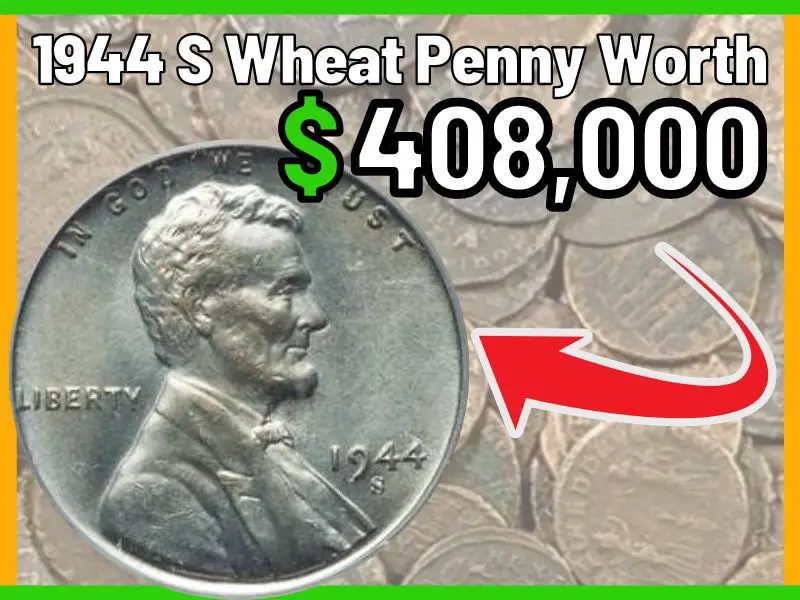
1944 wheat pennies are not rare, but they sell at prices higher than their face value depending on their attributes and grade. A 1944-S wheat penny value sits at $0.50 in extremely fine condition and as much as $2.31 in excellent uncirculated condition.
However, finding a 1944-S steel wheat penny can fetch you over $100,000 because of its rarity. Coins of this type are extremely rare, and while we will discuss the common series in this article, we will also cover the very valuable ones.
The Lincoln Wheat Penny Series
This coin series is one of the most popular in the United States and among collectors. Coins under this series are generally not scarce and are quite easy to acquire except in certain peculiar situations.
While the series got its name from its obverse features, some collectors still prefer to use the late President to refer to it.
History
Although the Lincoln penny has undergone several design changes to its reverse through the years, it retains its initial obverse design. The coin’s story started back when President Theodore Roosevelt expressed displeasure at the state of US coins in 1904.
According to the late President, the coins lacked artistic merit, and he set about changing that. He sought to hire Augustus Saint-Gaudens, an American sculptor, to redesign the double eagle, eagle, half eagle, quarter eagle, and the cent.
Saint-Gaudens initially depicted a flying eagle for the cent but couldn’t use it because an eagle can’t be on a cent. While the sculptor used the design for the double eagle, he could not submit another sketch for the cent before he passed away in 1907. He had been battling cancer while working on the projects.
This sad event left the cent’s redesign unfinished, and prior to Abraham Lincoln’s birth centennial in February 1909, citizens were requesting a Lincoln coin. The US Mint contracted the cent’s new design to Victor David Brenner.
Brenner initially made depictions similar to the reverse on French silver coins, which the Mint director rejected. The sculptor later used two ears of durum wheat for the coin’s reverse, giving it the nickname Wheat Penny.
1944 Wheat Penny
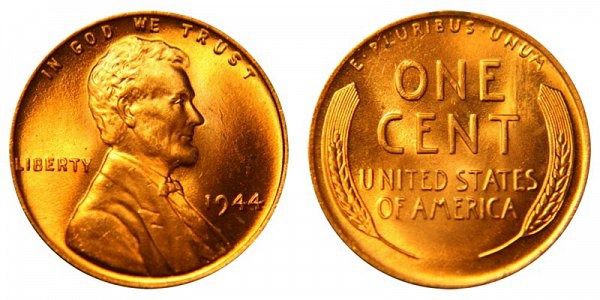
ted in 1944 had the same component and weight as several others in the wheat series. With a composition of 95% copper and 5% tin and zinc, the coins weigh 3.11 grams and have a diameter of 19mm.
However, the 1944 wheat series has an extremely valuable variety making it unique and popular among collectors.
| 1944 Lincoln Wheat Cent Bronze Composite Penny | |
| Year | 1944 |
| Composition | 95% Copper, 5% Zinc |
| Total Weight | 3.11 grams |
| Diameter | 19.00 mm |
| Edge | Plain |
| Designer | Victor David Brenner |
| 1944 Steel Wheat Penny | |
| Year | 1944 |
| Composition | Steel Coated Zinc |
| Total Weight | 2.7 grams |
| Diameter | 19.00 mm |
Features
Obverse
The coin’s obverse has a right-side bust of Lincoln at its center, with its production year in the right area and the word “LIBERTY” stuck on the coin’s left area. The sentence “IN GOD WE TRUST” lies engraved along the coin’s top.
If the coin carries a mintmark, you will find it struck directly under the coin’s production year.
Reverse
Two ears of durum wheat are struck on the coin’s reverse; one on either side. At the center, you will find the coin’s denomination in the words: “ONE CENT” and “UNITED STATES OF AMERICA” struck under it.
Finally, the mint’s famous motto “E * PLURIBUS * UNUM” is engraved along the coin’s top. The sentence Latin for “Out of many, one.”
Mints and Varieties
| 1944 Wheat Penny | |||
| Types | Location | Mint Mark | Minted |
| 1944 P | Philadelphia | No Mint Mark | 1,435,400,000 |
| 1944 P Steel Cent | Philadelphia | No Mint Mark | 30 |
| 1944 D | Denver | “D” | 430,578,000 |
| 1944 D Steel Cent | Denver | “D” | 7 |
| 1944 D D Over S | Denver | “D” | N/A |
| 1944 S | San Francisco | “S” | 282,760,000 |
| 1944 S Steel Cent | San Francisco | “S” | 2 |
Bronze Series
Even though three mints struck the 1944 wheat penny series, there are more than 3 varieties.
1944 Wheat Penny No Mintmark
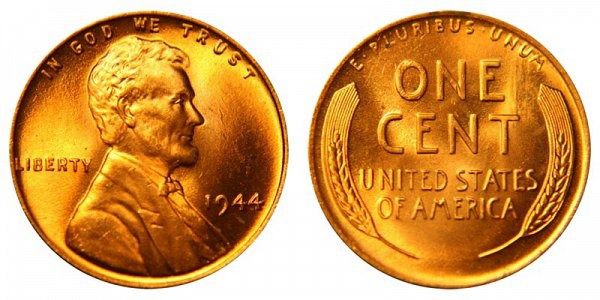
The Philadelphia mint struck a total of 1,435,400,000 wheat pennies in 1944, giving this variety the highest mintage. With such abundance, this variety is easy to find or acquire and has a low value.
These coins don’t carry a mintmark, hence the indication in their descriptions.
1944-D Wheat Penny
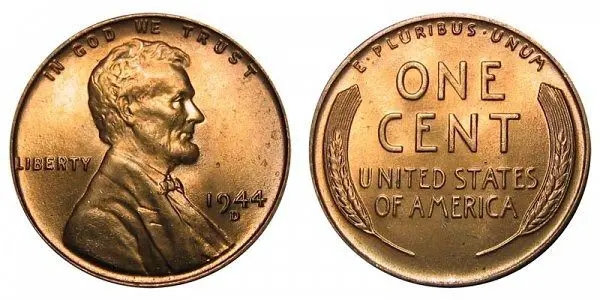
With a total of 430,578,000, the Denver variety had the second highest mintage. However, this coin’s value isn’t different from the other common ones.
The presence of a “D” mintmark means the coin was struck at the Denver mint.
1944-S Wheat Penny
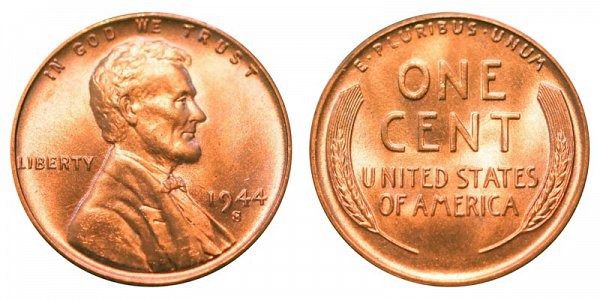
Although this variety had the lowest mintage, the San Francisco mint struck a total of 282,760,000, putting it well in the category of common low-value coins.
You will easily identify this coin through the presence of the “S” mintmark on its obverse.
1944 D over S Wheat Penny
This variety came up as a result of an Overpunched mintmark error (OMM). The Denver mint struck its “D” mintmark over an existing but subtle “S” mintmark, hence the name.
Although numismatists do not have an estimate of how many were struck, they were enough to make it known among collectors. You can easily tell by the arrow above the “D.”
Coins of this variety have a significantly higher value than the standard ones because of their uniqueness and rarity. One in good condition can sell for $55, while it can go for as much as $752 with an MS 63.
Steel Series
In 1944, the government tried diverting its copper into ammunition for World War II and substituted it with steel for the Lincoln wheat penny. However, this endeavor stopped because the new coins were problematic.
First off, they wore off easily because they were made of steel-coated zinc, leading to several complaints from the public. Also, lots of people couldn’t differentiate between the coins and other denominations of similar make.
Several decades later, these coins are massively sought after, giving them extremely high value. The coins have low mintages, further adding to their rarity and value.
1944 Steel Wheat Penny No Mintmark
This steel wheat penny variety had a mintage of only 30, making it very valuable, especially in excellent conditions.
Grade |
Price |
Extremely Fine (XF 40) |
$28,210 |
About Uncirculated (AU 50) |
$33,981 |
Uncirculated (MS 63) |
$57,109 |
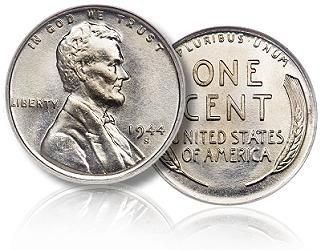
1944-D Steel Wheat Penny
The Denver mint struck only seven of this variety, and although numismatists believe there are more, none other have been found. This also goes for the other 1944 steel penny series.
Grades |
Price |
Extremely Fine (XF 40) |
$33,981 |
About Uncirculated (AU 50) |
$45,585 |
Uncirculated (MS 63) |
$60,537 |
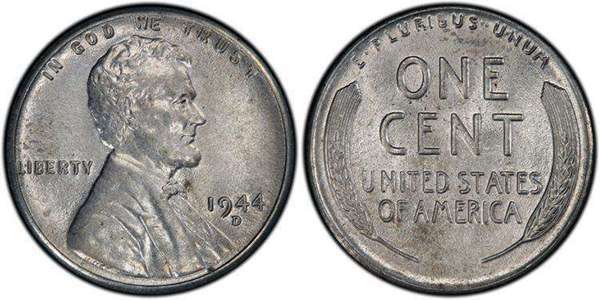
1944-S Steel Wheat Penny
With a mintage of just two, this variety is the rarest and also the most expensive. Only time will confirm if there are more or not.
Grades |
Price |
Extremely Fine (XF 40) |
$399,637 |
About Uncirculated (AU 50) |
$551,320 |
Uncirculated (MS 63) |
$741,587 |
Brilliant Uncirculated (MS 63) |
$1,110,923 |
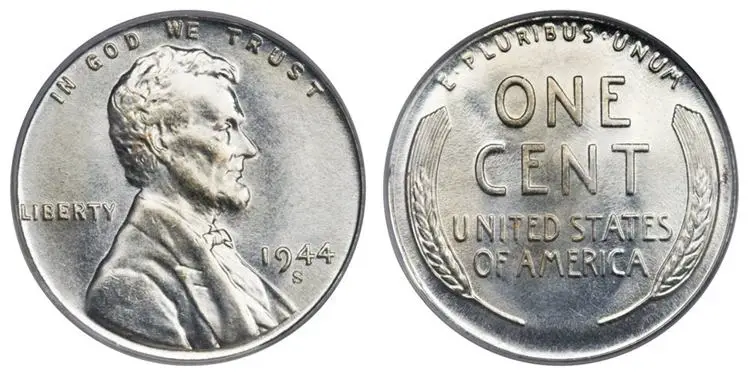
*Source: USA Coin Book
How Rare is the 1944-S Wheat Penny?
Although it has the lowest mintage of the series, the 1944-S wheat penny cannot be considered rare because its mintage is well above 10 million. On the upside, this ensures that anyone looking to build a collection can easily start with this coin.
However, if you are looking to sell one for some cash, the coin won’t fetch that much compared to rarer ones. But then, you will find that it is quite popular and loved among collectors for good reason.
On the other hand, the 1944-S steel penny is one of the rarest pennies, and although it is well known, it is severely limited in supply. Finding one in brilliant uncirculated condition can potentially make you a millionaire!
Even though melting it down will only yield $0.0006, with just two coins known to numismatists, the 1944-S steel penny has a value far above its melt value, going as high as 7 figures!
1944-S Wheat Penny Value
As with other coins, other factors and attributes can bump up the value of your 1944-S wheat penny. They include the following:
Grade
Grading a coin helps to determine and sum up its condition, making it easy to attach a value to it and incorporating it into a collection. It indicates the coin’s appearance, eye appeal, and preservation state.
Collectors use the Sheldon Numerical Scale to grade coins, and we will discuss the main categories below.
Circulated Condition
This condition covers grades for coins that have been spent or circulated. It is quite common to observe wear and varying degrees of damage because of frequent exchanges.
Good
This grade depicts a coin in its worst but sellable state. As such, you will easily observe discoloration, heavy wear, and damage on the coin with the naked eye. Some might even have breaks and heavy scratches.
Generally, coins with this grade have the lowest value because no one can distinguish the larger portion of their features.
Fine
The Fine grade covers coins in slightly better states than the previous grade. Coloration is not uniform, but scratches are less intense, if there are any, and you will observe the wear more around the coins’ center.
Intricate details like Lincoln’s hair and beard will be smooth due to wear.
Extremely Fine (XF)
Coins in Extremely Fine states have minimal scratches and wear, with coloration remaining intact but lacking luster. You will also be able to observe intricate details on Lincoln’s bust.
This grade gives the most value to coins in circulated condition.
Uncirculated Condition
This condition includes the grades for coins that have been well preserved and never spent or circulated.
Mint State (MS 60 -70)
As its name indicates, coins with this grade retain all their features from production. At higher levels, you will notice the luster of freshly minted coins.
It is normal for coins in this condition to have the highest values because they serve as a sort of time capsule, taking you back to the time when they were struck.
Rarity
A coin’s mintage directly influences its rarity because it dictates the number of obtainable coins in the series. High mintage reduces rarity by making the coin abundant enough to be considered common.
This attribute also affects the coin’s value as rare ones have greater values. In this case, only the steel wheat penny series have massive rarity, making the bronze series cheap and easy to acquire.
Error
Errors like the Overpunched Mintmark we mentioned earlier will increase a coin’s value. The reason is that the feature is not as common as standard coins, adding to its appeal to collectors.
Other errors like Double Die Obverse and Reverse (DDO & DDR), Clipped planchets, and re-punches also increase a coin’s value inasmuch as the coin retains crucial details like its date and bust.
1944-S Wheat Penny Worth
Grade |
Price |
About Uncirculated (BU) RD |
$15.00 |
PCGS Mint State (MS 64) RD |
$18.99 |
NGC Mint State (MS 65) RD |
$10.50 |
NGC Mint State (MS 66) RD |
$20.00 |
NGC Mint State (MS 67) RD |
$75.00 |
5 Most Valuable 1944 Wheat Penny Ever Sold
| 5 Most Valubale 1903 Indian Head Penny | ||||
| No. | Type | Condition | Sold Date | Price |
| 1 | 1944-S Zinc-Coated Steel Lincoln Cent | MS66 | Aug 18, 2021 | $408,000 |
| 2 | Pristine 1944-S Steel Cent MS66 | MS66 | Jul 31, 2008 | $373,750 |
| 3 | 1944-S 1C MS67+ | MS67+ | Jun 9, 2019 | $2,400 |
| 4 | 1944-S 1C MS67+ | MS67+ | Dec 15, 2022 | $1,560 |
| 5 | 1944-S 1C MS67+ | MS67+ | Jan 10, 2019 | $960 |
1. 1944-S Zinc-Coated Steel Lincoln Cent, MS66 Sold on for: $408,000
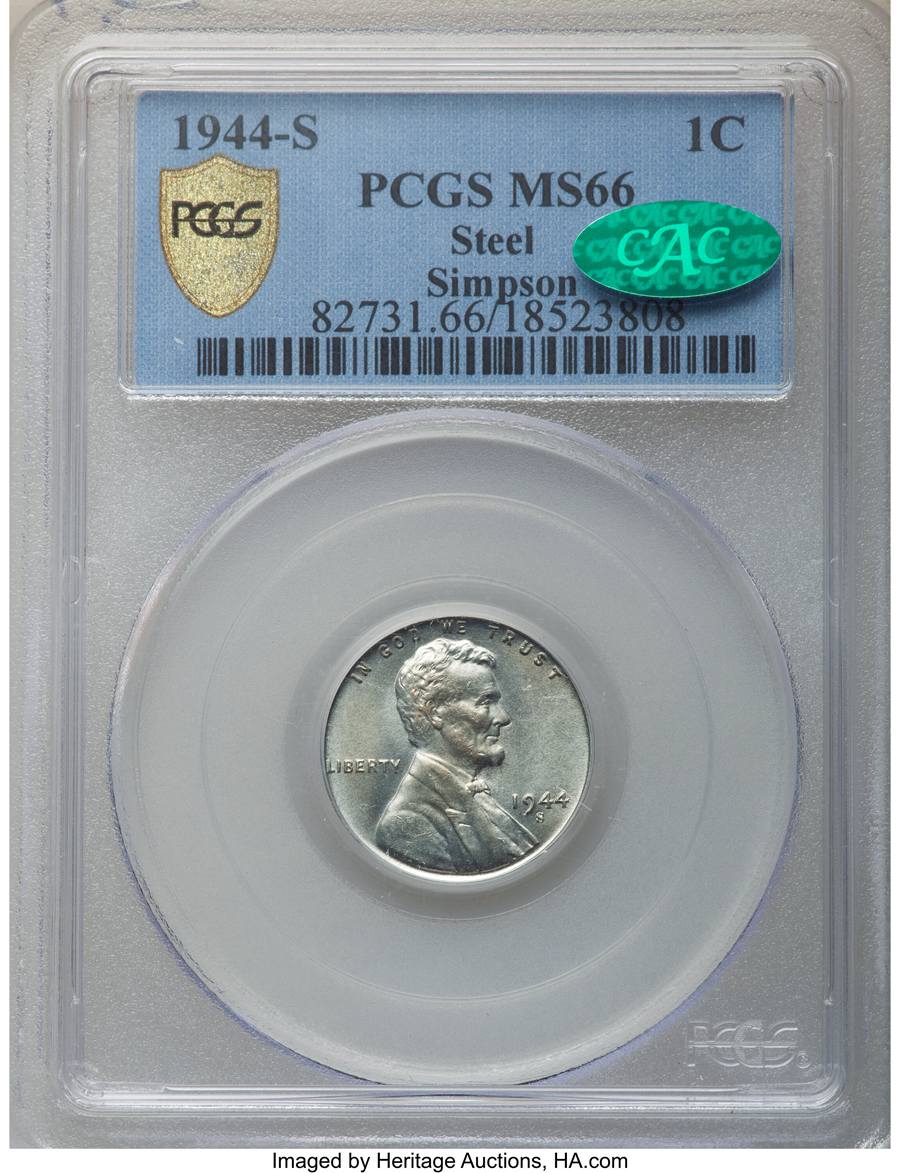
2. Pristine 1944-S Steel Cent MS66 Sold on Jul 31, 2008 for: $373,750
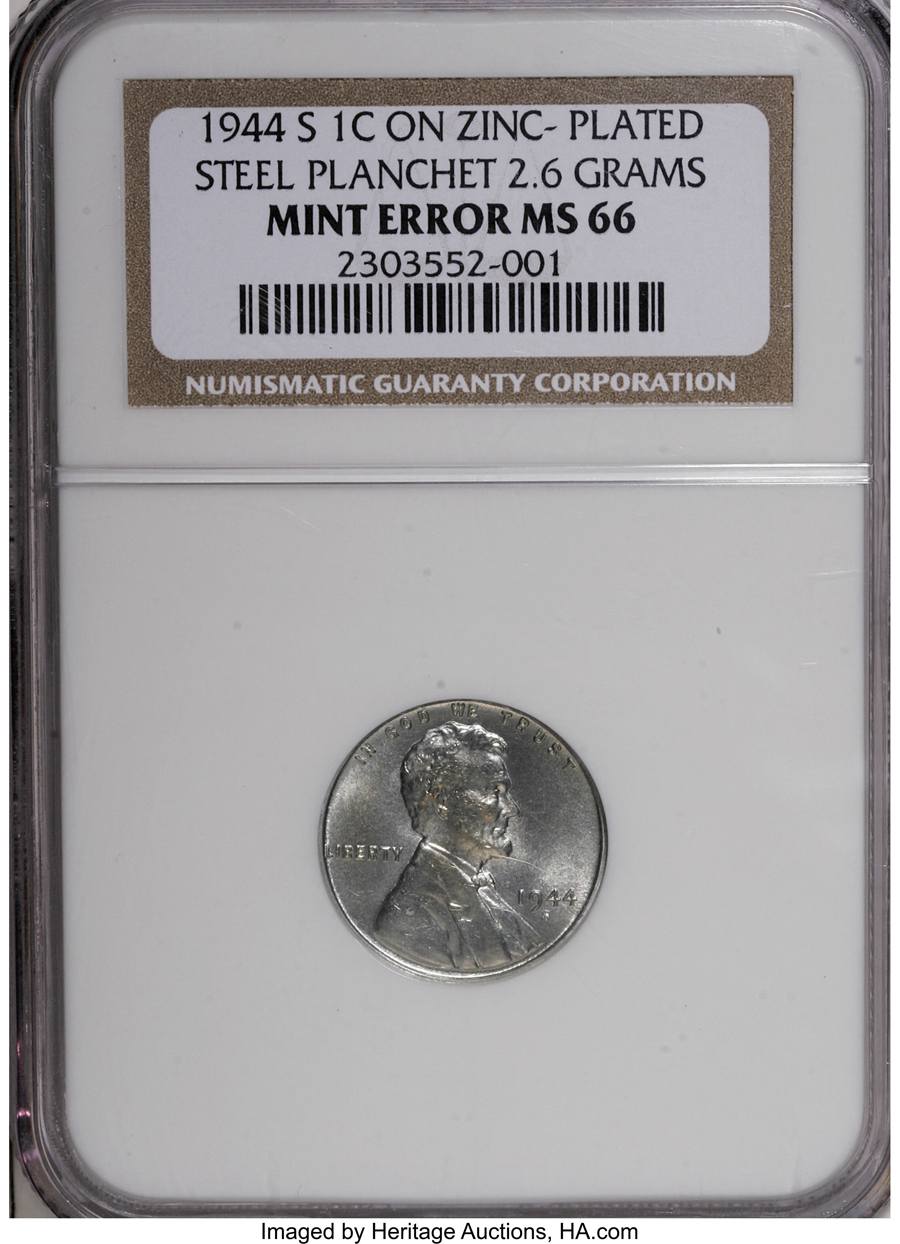
3. 1944-S 1C MS67+ Sold on Jun 9, 2019 for: $2,400
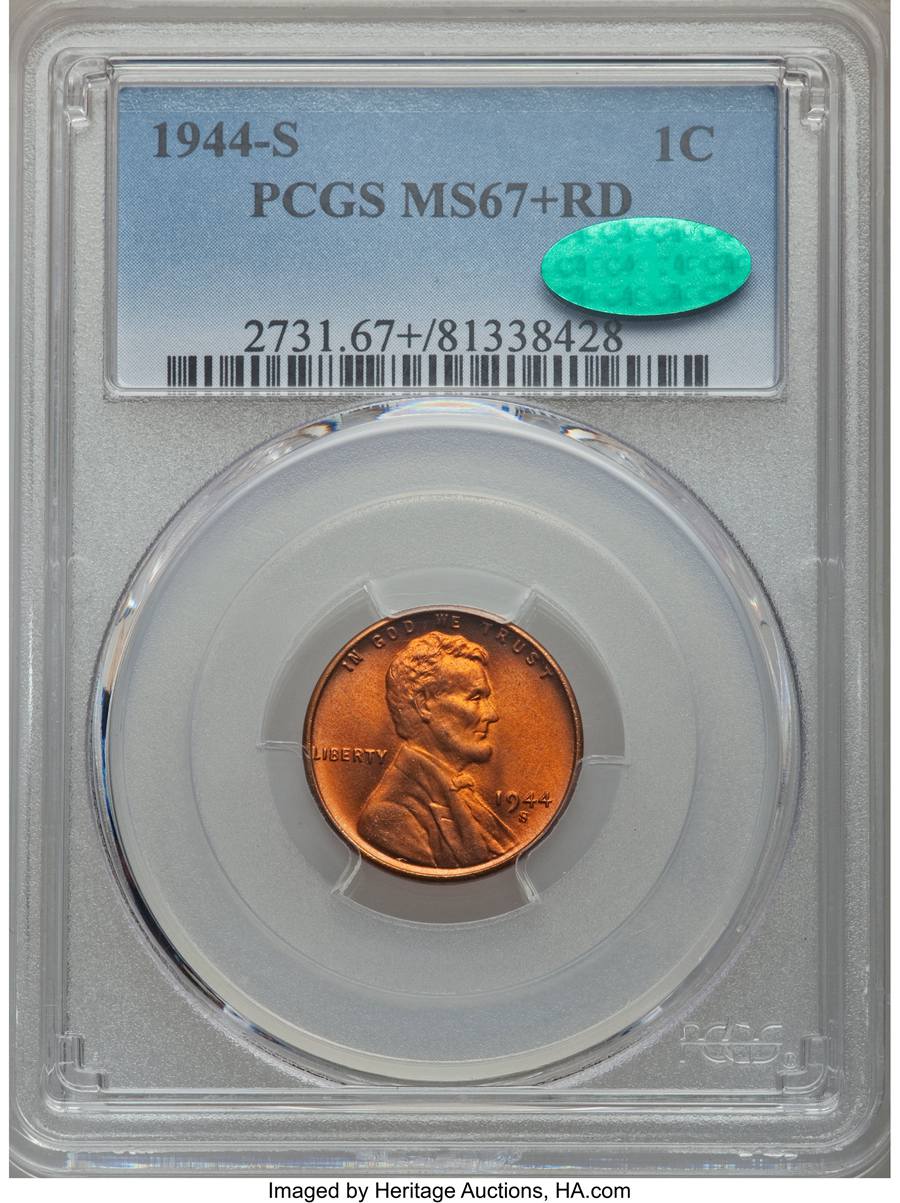
4. 1944-S 1C MS67+ Sold on Dec 15, 2022 for: $1,560
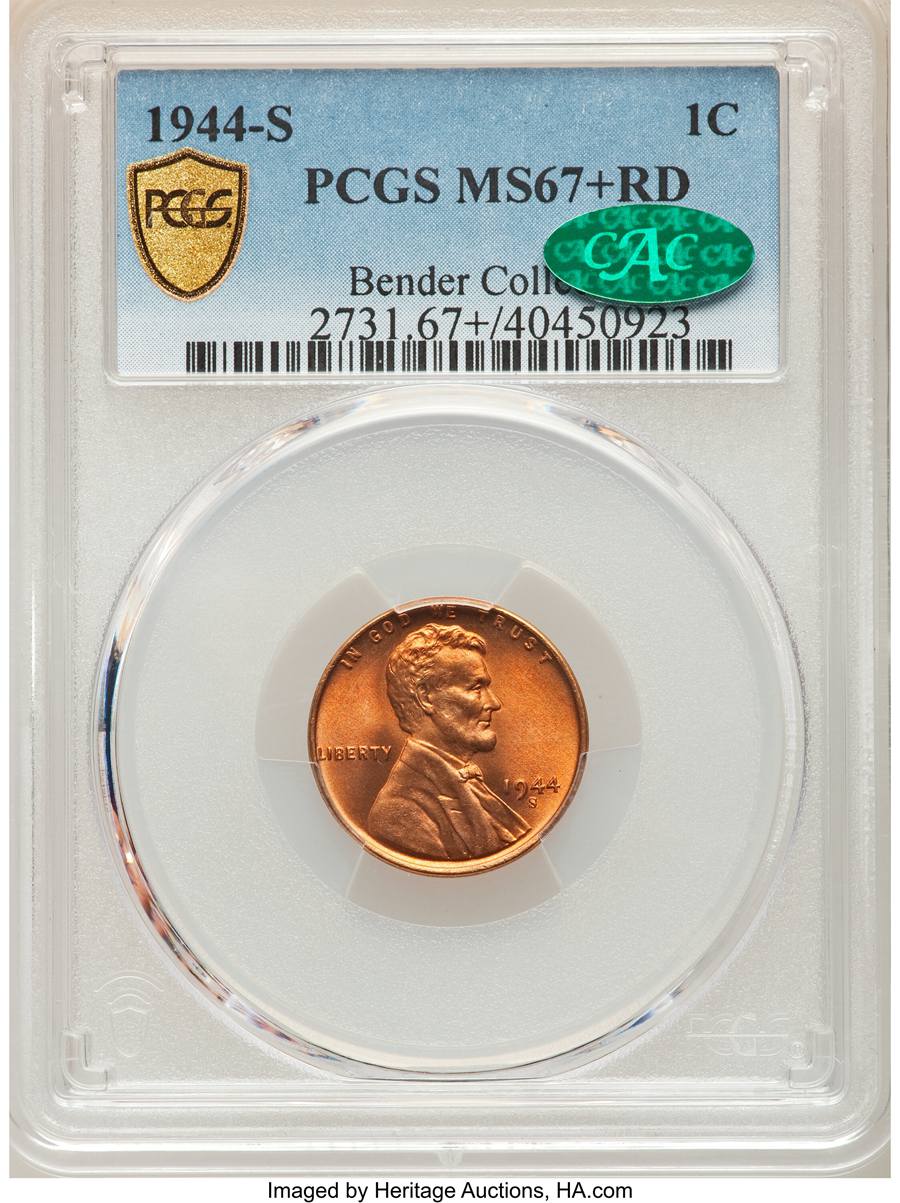
5. 1944-S 1C MS67+ Sold on Jan 10, 2019 for: $960
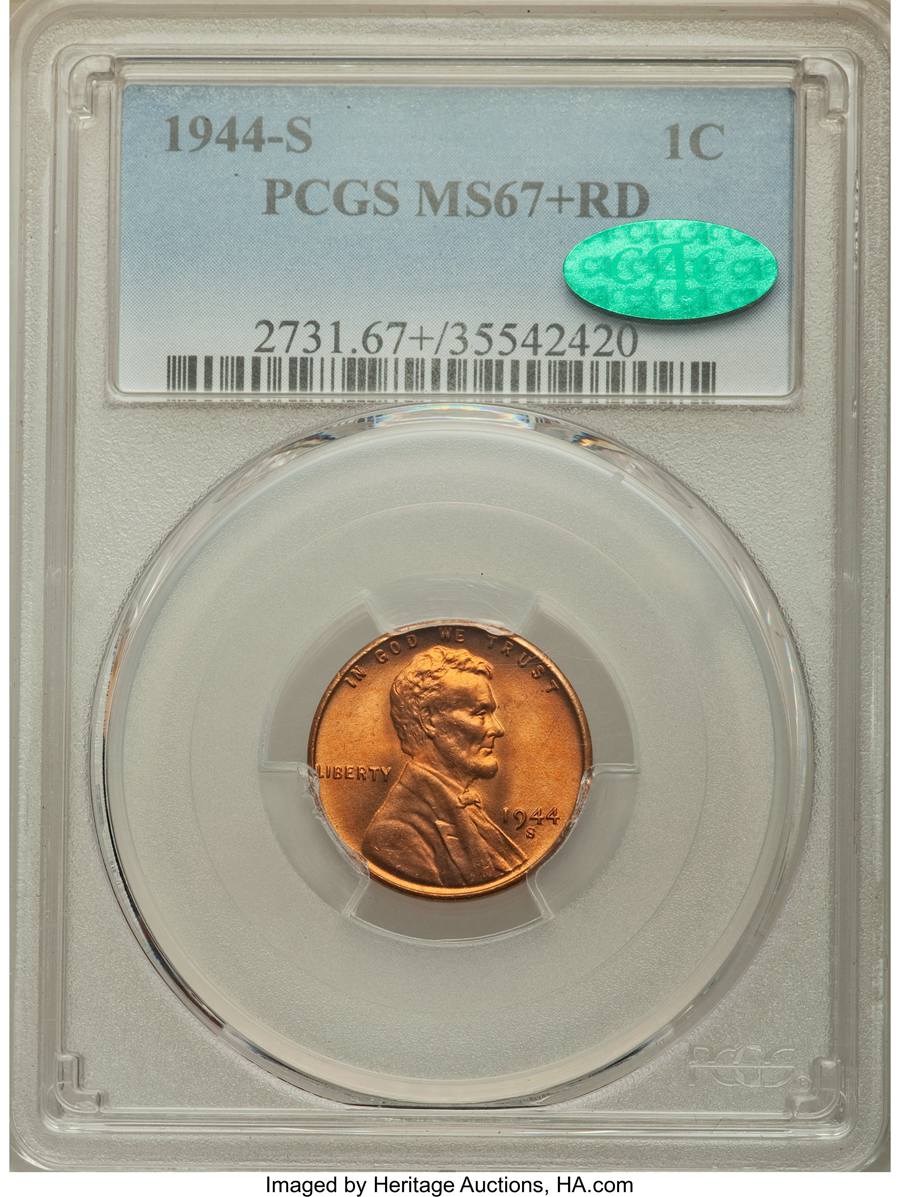
Where to Sell Your 1944-S Wheat Penny
Selling your 1944 wheat penny in the right place can also bump up its worth in addition to the other factors we discussed. The reason is that collectors value these coins higher than other people, and putting them for sale in the right outlet will bring you in contact with them, attracting better prices.
Going by this logic, you generally want to sell in a way that lets people bid on the coin, opening up the possibility of its final price exceeding your expectation.
That said, online platforms like eBay and Heritage Auctions meet this condition, making them excellent choices. Although you should grade your coin before listing, as this will help speed up the bidding process.
However, local coin dealers and pawn shops are the right places to go if you have a low-value coin and simply want some quick cash. While these options can potentially yield lesser value for the coin, they won’t mean much for coins with low values.
Wrapping Up
The 1944-S wheat penny has a low value because of its abundance, but that doesn’t reduce its popularity and importance to collectors. However, if you are looking to make a fortune, finding the 1944-S steel wheat penny is what you need.
With only two known coins for this variety, it is truly a treasure for any who finds one or both!
Nevertheless, the standard bronze composite variety is a good place to start if you want to build a collection.
